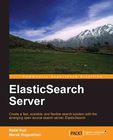I really like working on ElasticSearch, so powerful, so easy to use, so scalable and so high available. I’ve found a very interresting book I bought on it.
It will help you to start with ElasticSearch and answer a lot of question you may have regarding the product. If you want to buy it, take a look there.




